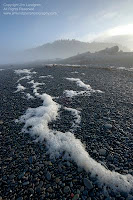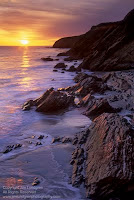 Get Down Low: I've said it before and I will say it again, "it ain't nature photography until you are getting your knees dirty." Lowering your viewpoint close to the ground is one of the easiest things you can do to improve your composition. Try using a wide angle lens and catch the waves rushing across the sand inches in front of you. Get down low next to that interesting rock formation at your feet and make it seem larger than life. Go get some sand on your pants and pebbles in your shoes. You will come home with some great images. Just remember to keep an eye on the waves and the camera out of the salt water!
Get Down Low: I've said it before and I will say it again, "it ain't nature photography until you are getting your knees dirty." Lowering your viewpoint close to the ground is one of the easiest things you can do to improve your composition. Try using a wide angle lens and catch the waves rushing across the sand inches in front of you. Get down low next to that interesting rock formation at your feet and make it seem larger than life. Go get some sand on your pants and pebbles in your shoes. You will come home with some great images. Just remember to keep an eye on the waves and the camera out of the salt water! Get Up High: Photographers spend most of their time on the beach when they are at the coast. You can consistently get great images on the sandy or rocky shores but don't pass up opportunities to shoot from the bluffs above. You can use wide angle lenses to include the details on the ground near you as well as the beach below. This is also a great opportunity to pull that long telephoto lens out of your bag and shoot down the beach. Longer focal lengths compress the foreground and the background, creating some very unique and interesting effects. But please, please make sure your tripod is secure when you are close to the edge of the cliff. I learned that the hard way (a story for another time).
Get Up High: Photographers spend most of their time on the beach when they are at the coast. You can consistently get great images on the sandy or rocky shores but don't pass up opportunities to shoot from the bluffs above. You can use wide angle lenses to include the details on the ground near you as well as the beach below. This is also a great opportunity to pull that long telephoto lens out of your bag and shoot down the beach. Longer focal lengths compress the foreground and the background, creating some very unique and interesting effects. But please, please make sure your tripod is secure when you are close to the edge of the cliff. I learned that the hard way (a story for another time).Change Your Speed: Put your camera on a tripod and use a small aperture to lengthen the shutter speed. Moving water will blur as it breaks across the sand. Shutter speeds near 1 second can create a soft silky ethereal effect to the water. You can also use faster shutter speeds to freeze the water in mid air, showing the power of a wave crashing against the rocks. Shutters speeds faster than 1/500 of a second can record spray as a myriad of drops suspended in mid-flight. Try varying the shutter speed and experiment with the results.
Stay Up Late-Get Up Early: Time of day...Time of day...Time of day. I can't say those three words enough. If a scene is beautiful during the afternoon hours, it will be spectacular during the evening hours. Eat an early dinner and get out there near sunset. Drag yourself out of bed before sunrise and you will be rewarded. Warm tones and long shadows give depth to subjects and create visual lines through the image. And please don't leave the minute the sun goes down. Professional photographers call the next hour of light "the magic hour" for a reason. The colors can reflect off the clouds in spectacular fashion and the entire landscape is frequently bathed in a soft diffused glow. Oranges and reds give way to dark blue skies as night begins to fall. Don't forget your tripod. Exposures are frequently several seconds long. You have my permission to leave when you can't see the controls on the camera any more.
Bad Weather-No Problem: Many photographers frequently cancel their photo shoots outdoors as soon as the rain begins. I promise that there is no other consistently dramatic moment than the first minutes when a storm begins to clear. If you are not there, toughing out the weather, you are not going to be there when the clouds begin to part. Every time I get depressed as the rain continues to fall, I try to stay motivated by remembering most of my best images were taken after enduring bad weather (sometimes for days on end). If nothing else, storms always lead to great stories to tell your friends.
The next time you are visiting the ocean's edge, try some of the techniques above and create some images that live up to your memories.



No comments:
Post a Comment